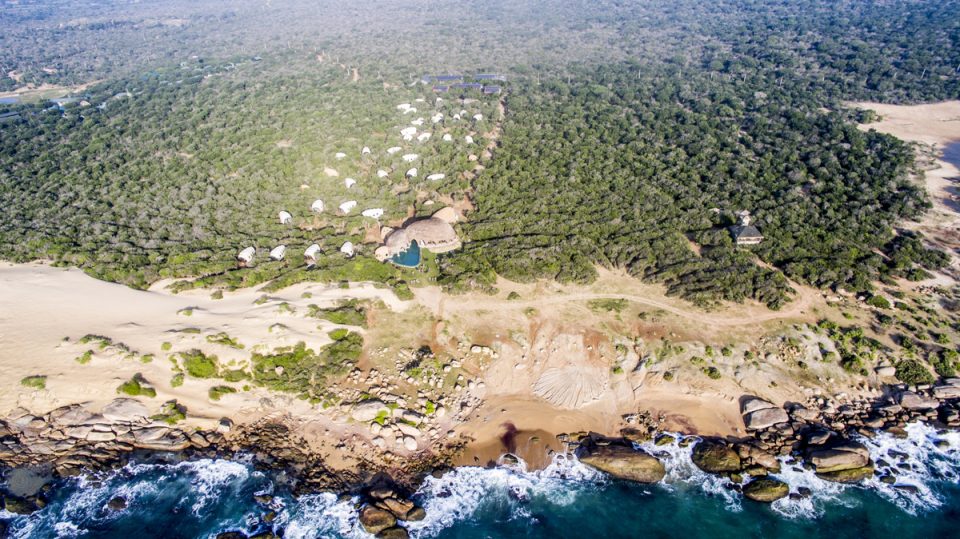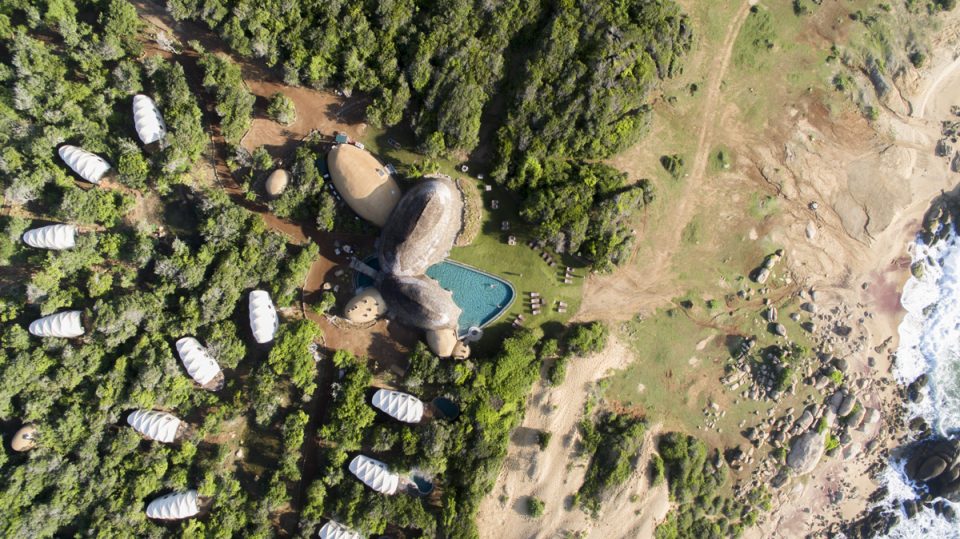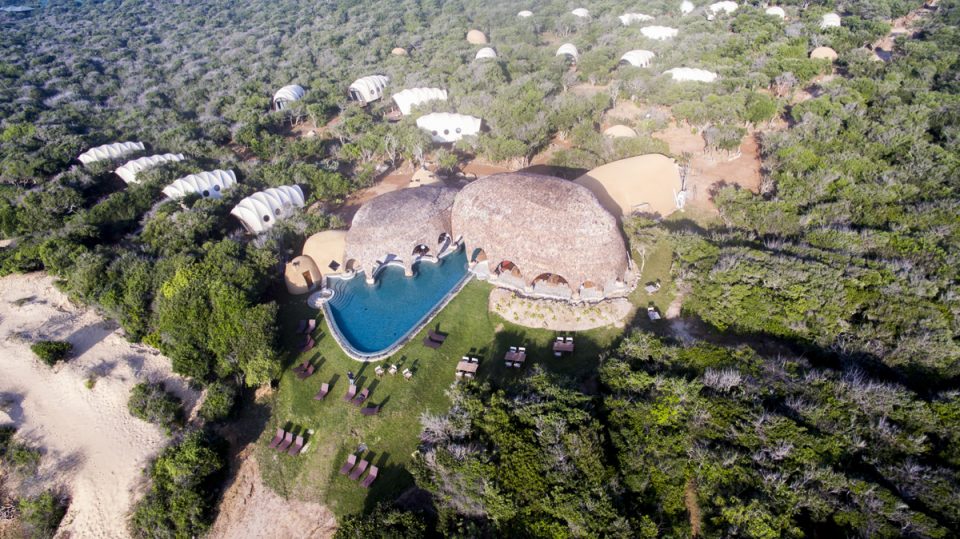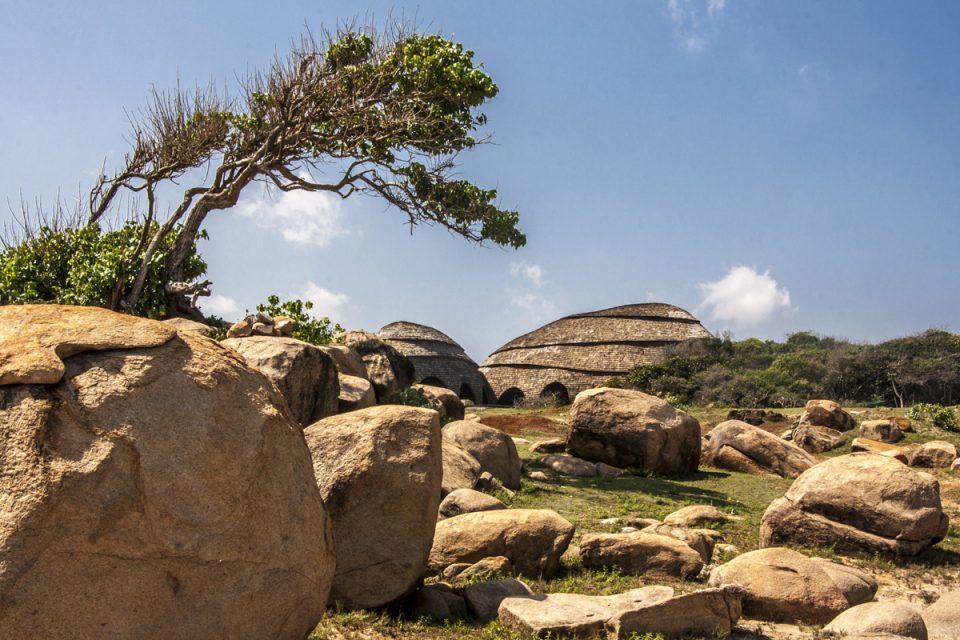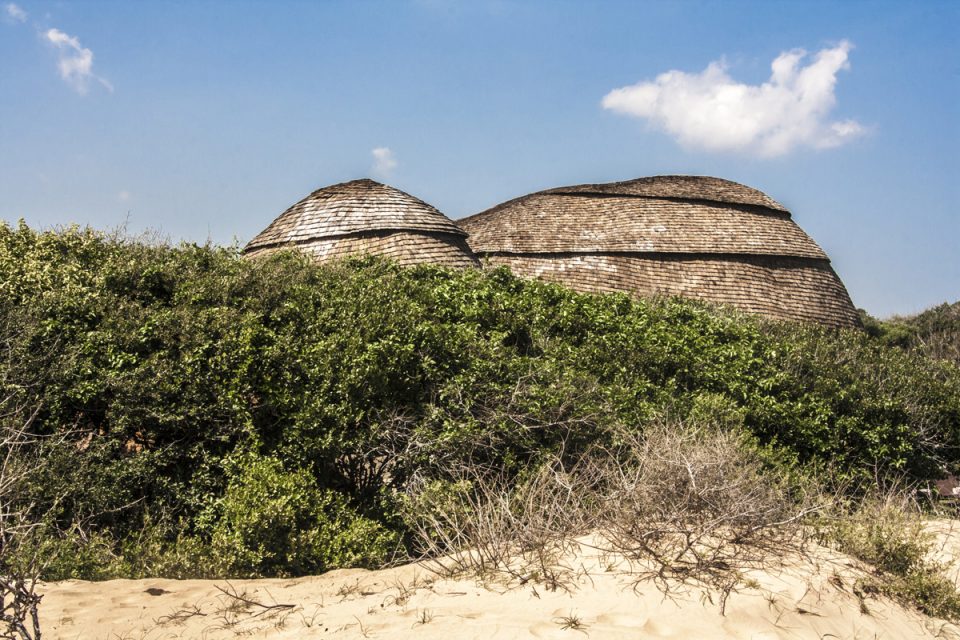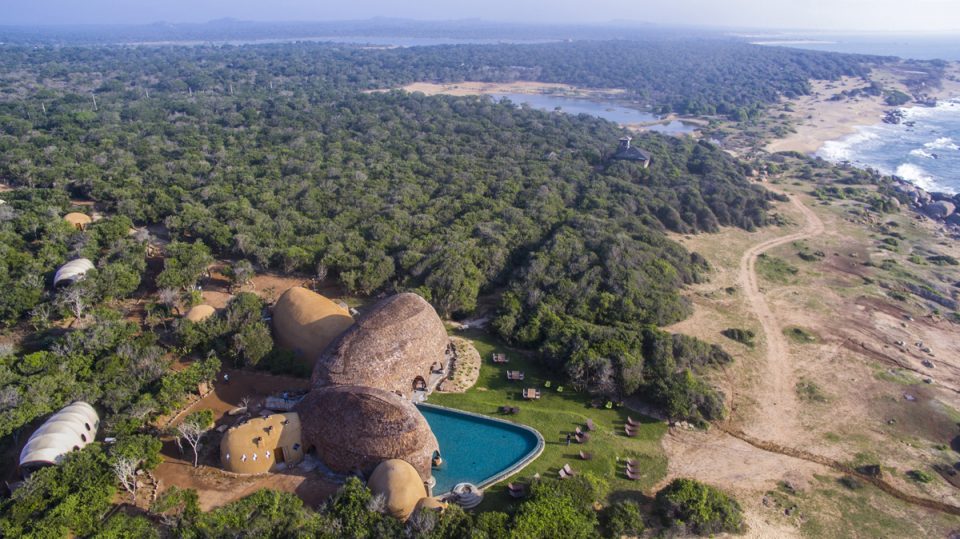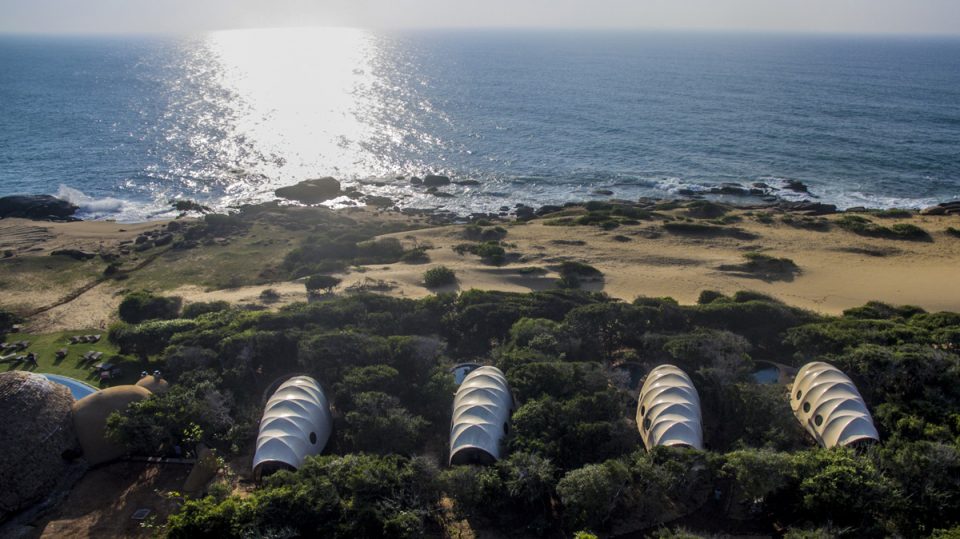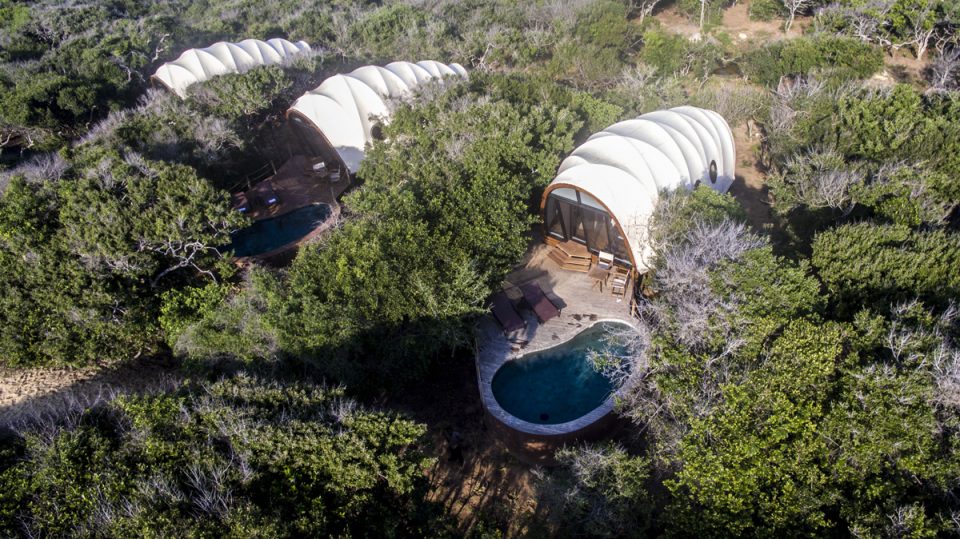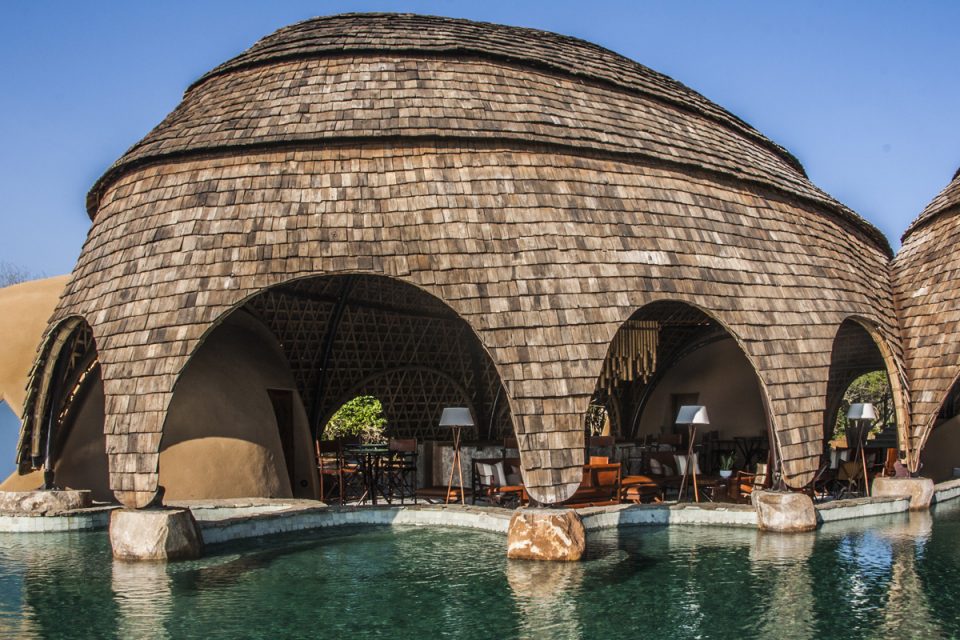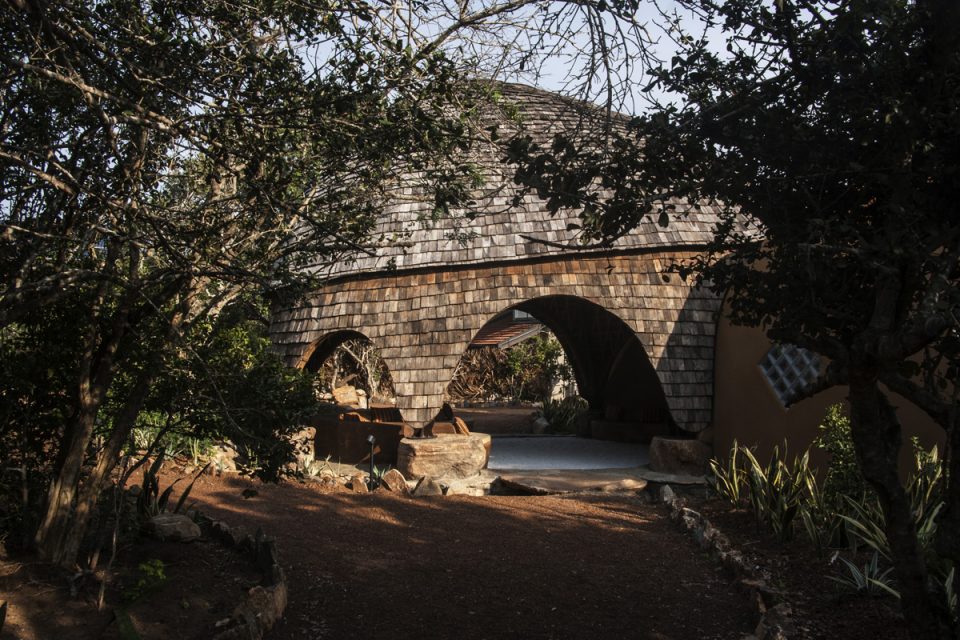斯里兰卡:海岸竹帐篷旅店 竹编 竹建筑

项目标签
设计公司: Bo Reudler Studio
位置: 斯里兰卡
类型: 竹编建筑
材料: 膜结构 木材 竹木
Wild Coast Tented Lodge坐落于斯里兰卡南部紧邻雅拉国家公园,是一座由36个帐篷形态建筑堆叠而成的旅行营地。在远眺印度洋景色,植根于沙地海岸的旱地森林处,这片旅行营地以其有机的建筑形态,与周围环境和谐相融。这座五星级的生态度假酒店,致力于为来访者带来非同一般的雅拉风情。让游客在亲密怡人的环境中,感受动植物群落和自然文化的馈赠。Resplendent Ceylon度假酒店由来自Nomadic Resorts的建筑师与来自Bo Reudler Studio的室内设计师共同打造。作为Dilmah Tea的子品牌,Resplendent Ceylon以其独特的度假酒店形式,吸引了一批又一批的来访者去探索和体会斯里兰卡的历史,文化与自然。
Wild Coast Tented Lodge is a 36-tent safari camp located on the edge of Yala National Park, in the south of Sri Lanka. Its organic architecture integrates seamlessly into the site, which comprises dryland forests that merge into the rugged sandy coastline overlooking the Indian Ocean. The five-star eco-resort is designed to give visitors an intimate experience of Yala, celebrating the flora, fauna and culture of the area with minimal intrusion on the landscape. A multidisciplinary team consisting of Nomadic Resorts (architecture and landscape design) and Bo Reudler Studio (interior design) designed the camp for Resplendent Ceylon, a subsidiary of Dilmah Tea, whose unique resorts offer curious travellers diverse experiences linked to Sri Lanka’s history, culture and nature.
▼鸟瞰图,aerial view


建筑
Architecture
在亚拉的半干旱地区和海岸线的沿途中散布着巨大的块状岩石,这一令人印象深刻的自然地貌是当地野生动物的栖息地。而无论是白蚁的穴丘或是挂在树上的蜂巢,无不从另一个微观的世界中重复着这一独特的自然形态。为了契合这一独特的生态景观,建筑设计师们从这一有趣的自然形态中汲取灵感,在宏观和微观之间找到了适宜人类栖息的最佳尺度。从当地建造传统与材料到社区融入,这种在地性贯穿了整个项目的设计始终。
Scattered across Yala’s semi-arid landscape and along the coastline are massive rocky outcrops; these impressive landmarks provide habitat for wildlife. These huge round formations are echoed at a micro scale by termite mounds and suspended beehives found throughout the park. To create a natural fit into Yala’s landscape, the architecture of the camp adopts a human scale between the existing macro and micro forms and derives its forms from these intriguing natural formations. The existing vegetation is retained to ensure an authentic experience of the landscape. Local influences form an integral part of the project, from vernacular traditions and materials to community involvement.
▼建筑模仿当地的地形地貌,the architecture mimic the landform

该度假酒店的主要服务设施分设场地两边,俯瞰过去形如露出地面的巨大卵石。较大的公共露天空间与较小的私密空间在相交的拱顶下获得连接。入口迎宾处,酒吧,餐厅和图书阅览室彼此相连,如同场地中的天然景观,一簇簇茧状的张力膜结构则散布在场地之中。群聚的张力膜结构单体如同豹爪一般印刻在场地中,而位于其下的水池,则吸引了无数野生动物前来光顾。在此休闲的游人们可以栖身于较高处的甲板上,俯瞰这些到访的不速之客,保障了游人的人身安全。温泉浴于海岸处略向后退,掩映在一片Palu树林之中。
Positioned at either end of the site, the main facilities are organised as outcrops of boulder-like pavilions clustered organically together. Larger open air volumes intersect with smaller enclosed domes that house more private functions. Connecting the welcome area near the entrance with the waterfront bar, restaurant and library is a meandering natural landscape lined with clusters of cocoon-like tensile membrane structures called Loopers. Each cluster, which resembles a leopard paw print, overlooks a watering hole designed to attract wildlife. Guests can admire the wildlife from the safety of elevated decks at the front of their tents. The spa is set back from the beachfront, nestled amid a grove of Palu trees.
▼主空间如同地面上巨大的卵石,the main facilities are organised as outcrops of boulder-like pavilions

▼群聚的张力膜结构单体如同豹爪一般印刻在场地中, cluster of Loopers resembles a leopard paw print


远远望去,巨大凉棚给人以敦实厚重之感,近而观之,来访者便会惊讶于它质轻和开放的结构。建筑的圆顶由编织而成的竹网结构搭配柚木瓦片而成。四周巨大的拱形开口和高圆顶天花板营造了强烈的空间感,而层层向上的同心圆通风缝,则把建筑再次拉回到人的尺度。随着时间的推移柚木瓦片逐渐被风化,苔藓爬满周围的碎石,建筑也在优雅中渐渐老化。夜色中的大厅如同指路明灯,封闭的结构外壳被照亮,开放的结构内部也渗透出光亮。布置在环形通风口上的LED光条,将这一夜间效果描绘的更加鲜明。
From afar, the large pavilions appear solid but on closer inspection, they’re revealed as light, open structures. Their vaulted construction is crafted from a woven grid shell bamboo structure clad in reclaimed teak shingles. Large, arched openings and high vaulted ceilings create a strong sense of space while concentric ventilation slits help reduce the volumes to a more human scale. As the shingles weather, the buildings will age gracefully over time, and gain a patina that naturally complements the surrounding stone. By night, the illuminated pavilions appear as navigational landmarks – the enclosed structures are lit from the outside, while the open structures are illuminated from within, creating an inviting glow. This effect is accentuated by striking rings of light from LED strips that line the ventilation openings.
▼巨大的拱形开口和高圆顶外貌,the big arch openings and high vaulted ceilings


建筑
Architecture
在亚拉的半干旱地区和海岸线的沿途中散布着巨大的块状岩石,这一令人印象深刻的自然地貌是当地野生动物的栖息地。而无论是白蚁的穴丘或是挂在树上的蜂巢,无不从另一个微观的世界中重复着这一独特的自然形态。为了契合这一独特的生态景观,建筑设计师们从这一有趣的自然形态中汲取灵感,在宏观和微观之间找到了适宜人类栖息的最佳尺度。从当地建造传统与材料到社区融入,这种在地性贯穿了整个项目的设计始终。
Scattered across Yala’s semi-arid landscape and along the coastline are massive rocky outcrops; these impressive landmarks provide habitat for wildlife. These huge round formations are echoed at a micro scale by termite mounds and suspended beehives found throughout the park. To create a natural fit into Yala’s landscape, the architecture of the camp adopts a human scale between the existing macro and micro forms and derives its forms from these intriguing natural formations. The existing vegetation is retained to ensure an authentic experience of the landscape. Local influences form an integral part of the project, from vernacular traditions and materials to community involvement.
▼建筑模仿当地的地形地貌,the architecture mimic the landform
该度假酒店的主要服务设施分设场地两边,俯瞰过去形如露出地面的巨大卵石。较大的公共露天空间与较小的私密空间在相交的拱顶下获得连接。入口迎宾处,酒吧,餐厅和图书阅览室彼此相连,如同场地中的天然景观,一簇簇茧状的张力膜结构则散布在场地之中。群聚的张力膜结构单体如同豹爪一般印刻在场地中,而位于其下的水池,则吸引了无数野生动物前来光顾。在此休闲的游人们可以栖身于较高处的甲板上,俯瞰这些到访的不速之客,保障了游人的人身安全。温泉浴于海岸处略向后退,掩映在一片Palu树林之中。
Positioned at either end of the site, the main facilities are organised as outcrops of boulder-like pavilions clustered organically together. Larger open air volumes intersect with smaller enclosed domes that house more private functions. Connecting the welcome area near the entrance with the waterfront bar, restaurant and library is a meandering natural landscape lined with clusters of cocoon-like tensile membrane structures called Loopers. Each cluster, which resembles a leopard paw print, overlooks a watering hole designed to attract wildlife. Guests can admire the wildlife from the safety of elevated decks at the front of their tents. The spa is set back from the beachfront, nestled amid a grove of Palu trees.
▼主空间如同地面上巨大的卵石,the main facilities are organised as outcrops of boulder-like pavilions
▼群聚的张力膜结构单体如同豹爪一般印刻在场地中, cluster of Loopers resembles a leopard paw print
▼位于Loopers下坡的水池吸引了无数野生动物,the Loopers overlook a watering hole designed to attract wildlife
远远望去,巨大凉棚给人以敦实厚重之感,近而观之,来访者便会惊讶于它质轻和开放的结构。建筑的圆顶由编织而成的竹网结构搭配柚木瓦片而成。四周巨大的拱形开口和高圆顶天花板营造了强烈的空间感,而层层向上的同心圆通风缝,则把建筑再次拉回到人的尺度。随着时间的推移柚木瓦片逐渐被风化,苔藓爬满周围的碎石,建筑也在优雅中渐渐老化。夜色中的大厅如同指路明灯,封闭的结构外壳被照亮,开放的结构内部也渗透出光亮。布置在环形通风口上的LED光条,将这一夜间效果描绘的更加鲜明。
From afar, the large pavilions appear solid but on closer inspection, they’re revealed as light, open structures. Their vaulted construction is crafted from a woven grid shell bamboo structure clad in reclaimed teak shingles. Large, arched openings and high vaulted ceilings create a strong sense of space while concentric ventilation slits help reduce the volumes to a more human scale. As the shingles weather, the buildings will age gracefully over time, and gain a patina that naturally complements the surrounding stone. By night, the illuminated pavilions appear as navigational landmarks – the enclosed structures are lit from the outside, while the open structures are illuminated from within, creating an inviting glow. This effect is accentuated by striking rings of light from LED strips that line the ventilation openings.
▼巨大的拱形开口和高圆顶外貌,the big arch openings and high vaulted ceilings
▼圆顶由编织而成的竹网结构搭配柚木瓦片而成,the vaulted construction is crafted from a woven grid shell bamboo structure clad in reclaimed teak shingles
景观
Landscape
度假酒店的景观营造既有效利用的场地资源,又得益于其视觉效果。在池塘的挖掘过程中,场地中发掘出常用于道路铺面的黏土和红土砾石。这些砾石常见于河床处,是环境中的不利因素。因此,设计师根据这些挖掘出的铺路材料对池塘大小做出了适当调整。为了能全部利用这些挖掘出的材料,设计师特别建造了一个旋转分离器将砾石和黏土分离开来,并进而用黏土打造泥砖内饰 。与此同时,被挖掘和分离出的砾石则用来修饰路径边界,Adrian Gray还特别将这些挖掘出的砾石打造成一系列雕塑。它们散布在场地中,为度假村环境锦上添花。园艺师在场地中的现有植被环境中融入节水型园艺。它们中的如Agave,Fucrea和Sanseveria(三种植物)等可以耐受长时间的干旱的针叶植物。身长的植物叶子与曲面的建筑形态形成鲜明的对比。
The landscaping cleverly utilises the qualities of the site, both visually and in terms of the resources. The excavation process for the ponds revealed a subsoil composed mostly of clay and laterite gravel commonly used for road and path surfacing. This gravel is often excavated from river beds, with detrimental environmental effects. The strategy therefore sized the ponds based on the material required for surfacing the pathways. To utilise the excavated material, a special rotating sieve was constructed to separate the gravel from the clay, which in turn, is used to create mud-brick interior features. Rock excavated from the main pool was used to edge the pathways. Dotted through the camp are a series of elegant rock balance sculptures by Adrian Gray created specifically using rocks found on the site. The existing vegetation is complemented by an attractive xeriscape of spiky plants such as Agave, Fucrea and Sanseveria that are able to withstand long drought periods and contrast with the curvilinear forms of the buildings. An additional advantage is that they are unappetizing to the wildlife that roams freely through the site.
▼采用当地原生材料和耐旱植物作为场地景观,the landscaping cleverly utilises the qualities of the site, both visually and in terms of the resources


室内设计理念
Interior concept
由于建筑外部象征性地展现了岩石的形态,那么建筑内部则理所当然地描绘了岩石内部,如岩洞,水晶及各种珍稀的矿物纹理。该内部环境以当代设计手法,融入奢华的生态繁荣景象和优雅的本土特色,打造极具魅力的探索与发现之旅。呼应场地环境,建筑内部采用本土材料如石材,石英和泥砖,并搭配铜,黄铜,水磨石,木材,竹子和纺织品等营造丰富的空间基调。设计师特别注重建筑材料可以“优雅的老化”这一特质。一些如雕塑般的吊灯被置于度假村的主要空间内。
Whereas the architecture focuses on the outer form of the boulders, the interior recalls the treasures concealed within them such as caves, crystals and veins of precious minerals. Capturing a sense of discovery, adventure and enchantment, the interior combines ecological luxury and local elegance with a contemporary edge. Echoing the context of the site, local materials such as stone, quartz and mud brick are paired with a rich palette of copper, brass, terrazzo, wood, bamboo and textiles. A strong focus is placed on high quality materials that age gracefully. Sculptural light installations punctuate the main spaces.
▼与外貌相异的丰富内装,the diversity of the interior

建筑
Architecture
在亚拉的半干旱地区和海岸线的沿途中散布着巨大的块状岩石,这一令人印象深刻的自然地貌是当地野生动物的栖息地。而无论是白蚁的穴丘或是挂在树上的蜂巢,无不从另一个微观的世界中重复着这一独特的自然形态。为了契合这一独特的生态景观,建筑设计师们从这一有趣的自然形态中汲取灵感,在宏观和微观之间找到了适宜人类栖息的最佳尺度。从当地建造传统与材料到社区融入,这种在地性贯穿了整个项目的设计始终。
Scattered across Yala’s semi-arid landscape and along the coastline are massive rocky outcrops; these impressive landmarks provide habitat for wildlife. These huge round formations are echoed at a micro scale by termite mounds and suspended beehives found throughout the park. To create a natural fit into Yala’s landscape, the architecture of the camp adopts a human scale between the existing macro and micro forms and derives its forms from these intriguing natural formations. The existing vegetation is retained to ensure an authentic experience of the landscape. Local influences form an integral part of the project, from vernacular traditions and materials to community involvement.
▼建筑模仿当地的地形地貌,the architecture mimic the landform
该度假酒店的主要服务设施分设场地两边,俯瞰过去形如露出地面的巨大卵石。较大的公共露天空间与较小的私密空间在相交的拱顶下获得连接。入口迎宾处,酒吧,餐厅和图书阅览室彼此相连,如同场地中的天然景观,一簇簇茧状的张力膜结构则散布在场地之中。群聚的张力膜结构单体如同豹爪一般印刻在场地中,而位于其下的水池,则吸引了无数野生动物前来光顾。在此休闲的游人们可以栖身于较高处的甲板上,俯瞰这些到访的不速之客,保障了游人的人身安全。温泉浴于海岸处略向后退,掩映在一片Palu树林之中。
Positioned at either end of the site, the main facilities are organised as outcrops of boulder-like pavilions clustered organically together. Larger open air volumes intersect with smaller enclosed domes that house more private functions. Connecting the welcome area near the entrance with the waterfront bar, restaurant and library is a meandering natural landscape lined with clusters of cocoon-like tensile membrane structures called Loopers. Each cluster, which resembles a leopard paw print, overlooks a watering hole designed to attract wildlife. Guests can admire the wildlife from the safety of elevated decks at the front of their tents. The spa is set back from the beachfront, nestled amid a grove of Palu trees.
▼主空间如同地面上巨大的卵石,the main facilities are organised as outcrops of boulder-like pavilions
▼群聚的张力膜结构单体如同豹爪一般印刻在场地中, cluster of Loopers resembles a leopard paw print
▼位于Loopers下坡的水池吸引了无数野生动物,the Loopers overlook a watering hole designed to attract wildlife
远远望去,巨大凉棚给人以敦实厚重之感,近而观之,来访者便会惊讶于它质轻和开放的结构。建筑的圆顶由编织而成的竹网结构搭配柚木瓦片而成。四周巨大的拱形开口和高圆顶天花板营造了强烈的空间感,而层层向上的同心圆通风缝,则把建筑再次拉回到人的尺度。随着时间的推移柚木瓦片逐渐被风化,苔藓爬满周围的碎石,建筑也在优雅中渐渐老化。夜色中的大厅如同指路明灯,封闭的结构外壳被照亮,开放的结构内部也渗透出光亮。布置在环形通风口上的LED光条,将这一夜间效果描绘的更加鲜明。
From afar, the large pavilions appear solid but on closer inspection, they’re revealed as light, open structures. Their vaulted construction is crafted from a woven grid shell bamboo structure clad in reclaimed teak shingles. Large, arched openings and high vaulted ceilings create a strong sense of space while concentric ventilation slits help reduce the volumes to a more human scale. As the shingles weather, the buildings will age gracefully over time, and gain a patina that naturally complements the surrounding stone. By night, the illuminated pavilions appear as navigational landmarks – the enclosed structures are lit from the outside, while the open structures are illuminated from within, creating an inviting glow. This effect is accentuated by striking rings of light from LED strips that line the ventilation openings.
▼巨大的拱形开口和高圆顶外貌,the big arch openings and high vaulted ceilings
▼圆顶由编织而成的竹网结构搭配柚木瓦片而成,the vaulted construction is crafted from a woven grid shell bamboo structure clad in reclaimed teak shingles
景观
Landscape
度假酒店的景观营造既有效利用的场地资源,又得益于其视觉效果。在池塘的挖掘过程中,场地中发掘出常用于道路铺面的黏土和红土砾石。这些砾石常见于河床处,是环境中的不利因素。因此,设计师根据这些挖掘出的铺路材料对池塘大小做出了适当调整。为了能全部利用这些挖掘出的材料,设计师特别建造了一个旋转分离器将砾石和黏土分离开来,并进而用黏土打造泥砖内饰 。与此同时,被挖掘和分离出的砾石则用来修饰路径边界,Adrian Gray还特别将这些挖掘出的砾石打造成一系列雕塑。它们散布在场地中,为度假村环境锦上添花。园艺师在场地中的现有植被环境中融入节水型园艺。它们中的如Agave,Fucrea和Sanseveria(三种植物)等可以耐受长时间的干旱的针叶植物。身长的植物叶子与曲面的建筑形态形成鲜明的对比。
The landscaping cleverly utilises the qualities of the site, both visually and in terms of the resources. The excavation process for the ponds revealed a subsoil composed mostly of clay and laterite gravel commonly used for road and path surfacing. This gravel is often excavated from river beds, with detrimental environmental effects. The strategy therefore sized the ponds based on the material required for surfacing the pathways. To utilise the excavated material, a special rotating sieve was constructed to separate the gravel from the clay, which in turn, is used to create mud-brick interior features. Rock excavated from the main pool was used to edge the pathways. Dotted through the camp are a series of elegant rock balance sculptures by Adrian Gray created specifically using rocks found on the site. The existing vegetation is complemented by an attractive xeriscape of spiky plants such as Agave, Fucrea and Sanseveria that are able to withstand long drought periods and contrast with the curvilinear forms of the buildings. An additional advantage is that they are unappetizing to the wildlife that roams freely through the site.
▼采用当地原生材料和耐旱植物作为场地景观,the landscaping cleverly utilises the qualities of the site, both visually and in terms of the resources
室内设计理念
Interior concept
由于建筑外部象征性地展现了岩石的形态,那么建筑内部则理所当然地描绘了岩石内部,如岩洞,水晶及各种珍稀的矿物纹理。该内部环境以当代设计手法,融入奢华的生态繁荣景象和优雅的本土特色,打造极具魅力的探索与发现之旅。呼应场地环境,建筑内部采用本土材料如石材,石英和泥砖,并搭配铜,黄铜,水磨石,木材,竹子和纺织品等营造丰富的空间基调。设计师特别注重建筑材料可以“优雅的老化”这一特质。一些如雕塑般的吊灯被置于度假村的主要空间内。
Whereas the architecture focuses on the outer form of the boulders, the interior recalls the treasures concealed within them such as caves, crystals and veins of precious minerals. Capturing a sense of discovery, adventure and enchantment, the interior combines ecological luxury and local elegance with a contemporary edge. Echoing the context of the site, local materials such as stone, quartz and mud brick are paired with a rich palette of copper, brass, terrazzo, wood, bamboo and textiles. A strong focus is placed on high quality materials that age gracefully. Sculptural light installations punctuate the main spaces.
▼与外貌相异的丰富内装,the diversity of the interior
迎宾区
Welcome area
临近入口大门,迎宾处营造了真正的莅临之感。开放的接待中心让远道而来的游人们都能获得舒适的等候环境。该空间焦点为一处泥砖筑曲面墙休息室,由竹子打造的巨大枝形吊灯悬挂于此,给人带来深刻的印象。迎宾处竹做穹顶的拱形开口,与两个较小的钢丝网水泥建筑相交。这两个小建筑由粗糙的碎卵石铺面,作为办公室和洗手间之用。办公室一侧打开形成酒店登记柜台,柜台的背后是一面闪闪发光的石英墙。这一设计给予来访者一个特别的感受:如同从岩洞向内望,绚丽的水晶就掩藏在这粗糙的外貌之下。
Located near the entrance gate, the welcome area creates a true sense of arrival. An open reception awaits guests after their long journey. The interior centres on a curved mud-brick lounge with an impressive tiered bamboo chandelier above. The arched openings of the bamboo dome of the welcome pavilion intersect with two smaller enclosed ferro-cement domes – containing the offices and washrooms – clad in a rough exterior pebble dash finish. The open end of the office dome incorporates the check-in desk backed by a sparkling quartz wall, creating the impression of looking inside a geode, with its rough stone exterior and crystalline interior.
▼入口接待处,the reception space


酒吧和泳池
Bar and pool
酒吧柜台由一个闪亮的石英墙和一个铜管制成的瓶架打造成视觉的焦点。如钟乳石般巨大的竹子吊灯将空间印象雕刻的更加深刻。酒吧外围的泳池是该酒店另一个主要组成部分。酒吧与餐厅通过一座小桥相连,而泳池则恰好从两者之间穿过。来访者可以从度假区一侧游行40米穿,穿越建筑并最终到达滨海区。此外,该泳池还帮助冷却环境,并借由日光,在巨大的竹子穹顶中留下波光粼粼的水影。夜间在光导纤维灯的映衬下,泳池如夜空般闪烁。从泳池中出来,在酒吧的坐席上点一杯饮料,或者到泳池侧边的休息区喝酒谈天都是不错的选择。怀旧的家具摆设唤起了对那个充满探索与冒险时代的追忆。该空间采用皮质,铜,红木,石英和石英鹅卵石地板为主要材料。
The bar counter forms the centrepiece, displaying a sparkling wall of quartz and a bottle rack fashioned from copper pipe. A giant stalactite-inspired bamboo chandelier illuminates the bar surface.Wrapped around the bar, the pool is a feature element in the main area. It separates the bar from the restaurant, which are connected by an indoor bridge that marks the transition between these two main spaces. Guests can enter the pool from the resort side and swim 40 metres through the building towards the beachfront. The water also provides a natural cooling effect and beautifully reflects sunlight onto the vaulted bamboo ceilings. By night the pool twinkles like the night sky thanks to integrated fibre-optic lights. Drinks can be enjoyed either seated at the bar or, while taking a rest from swimming, from one of the seating niches carved into the sides of the pool between the big boulder footings. Campaign furniture evokes an era of discovery and adventure. Materials used include leather, copper, mahogany, quartz and quartz pebble floors.
▼泳池从餐厅与酒吧之间穿过,the pool separates the bar from the restaurant

▼酒吧柜台上方的竹子吊灯将空间印象雕刻的更加深刻,a giant stalactite-inspired bamboo chandelier illuminates the bar surface

▼酒吧与餐厅通过一座小桥相连, the bar and the restaurant are connected by an indoor bridge

餐厅
Restaurant
餐厅是朝大海方向最大的度假村建筑。巨大的拱形开口,十米高的圆顶天花板和流动的池水让室内外环境无缝衔接。室内设计聚焦在几个特别的设计上。泥砖筑造的空间里设有坐席和服务站。精心规划的平面布局让各个餐桌的望海视野最大化。形态有机的铜制吊灯垂吊于桌面之上,缓和了朴素坚实的泥砖墙面。闪亮的铜色阴影和嵌入墙内的烛台,为室内增添温和之感。白色砾石和天然石材地板则打造了独特的户外氛围。
Orientated towards the ocean, the restaurant is the largest pavilion. Inside flows seamlessly with the outside thanks to the generous arched openings, ten-metre-high vaulted ceiling and the movement of the water through the building. The interior focuses on several sculptural elements. Coated mud brick niches incorporate seating and service stations. The carefully- considered layout maximises ocean views for each table. Organically-shaped copper lamps hanging above the tables counterbalance the simplicity and solidity of the mud brick. The glowing copper shades and candle niches in the mud brick lend warmth. White gravel and natural stone floors create a distinct outdoor feel.
▼餐厅布局,the restaurant

▼餐厅拥有巨大的拱形开口和十米高的圆顶天花板,restaurant formed by the generous arched openings, ten-metre-high vaulted ceiling

▼精心规划的平面布局让各个餐桌的望海视野最大化,the carefully- considered layout maximises ocean views for each table.


可持续性与本地工艺
Sustainability and local craftsmanship
最小化环境影响和营造独立的度假村景观的双重要求,使得整个项目必须以可持续性的手法为设计核心。后方建筑屋顶的太阳能板可生产该度假酒店日常用电的40%。用于消化食物垃圾的沼气池同时为厨房提供能源,回收水可用于园艺灌溉,空调机的热量回收则用作对后方建筑的清洗用水进行加热。
项目尽可能采用本地原生天然材料来实现与周围环境的高契合度,并迎合当地的泥砖建筑建造传统。挖掘出的石材和采自本地的石英矿采被广泛运用于建造工程之中,而经过碎石分离而得的黏土残渣则混合大象粪便,打造出餐厅和迎宾区的泥砖坐席。竹子是一种坚硬且生长快速的可再生材料,而柚木瓦片也是可回收的。更重要的是,该度假酒店的建造是在与当地社区紧密配合下完成的。当地渔民与国际顾问团队合作完成了竹子帐篷的搭建。该度假酒店的主要空间的巨石基础的切割工程由当地的寺庙建造专家协助完成,而渔夫们编织渔网的巧手则帮助完成了建筑的张力膜结构。
▼夜景,night view

境道原竹 13年高端竹结构企业,专业为: 竹结构、竹建筑、竹装饰、竹景观等竹艺工程提供,竹结构相关咨询、竹结构设计深化、原竹材料生产、施工落地管理,等一系列服务。致力为客户提供卓越的一站式体验.电话400-8866075 021-58665611。
本案例内容和图片来自于网络,若涉及版权,请联系我公司进行及时删除!
点赞 (0)
相关新闻
related news
-

国内竹子缠绕技术开拓未来,竹子高铁更让人不可思议 惊艳世界
2022-03-09 -

热烈庆祝四川境道原竹建筑工程有限公司成立
2021-10-09 -

山脚下的特色竹建筑-泰国特色竹屋| 近距离聆听大自然的声音 竹建筑 竹结构
2022-04-21 -

国内经典项目之绍兴市:鲁迅外婆家 弶与小鸟雀竹编 特色竹景观
2022-01-06


